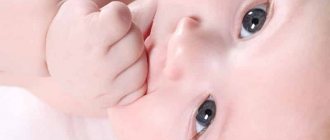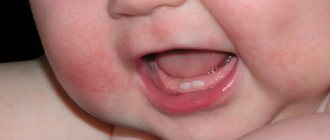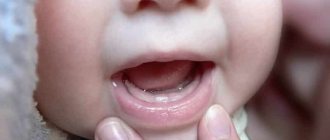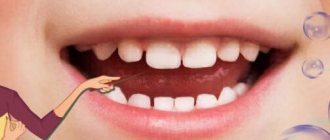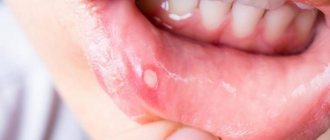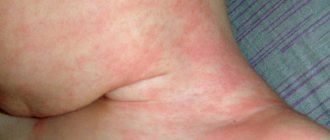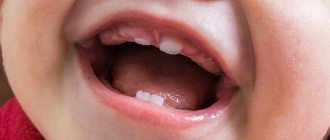At what age do the first teeth begin to erupt?
According to average statistics, a baby’s first teeth begin to emerge at the age of 5-8 months (see also: eruption of upper teeth in babies: photo of swollen gums).
There is no need to sound the alarm if this process started earlier or later for your little one. Each child, and therefore his body, is unique, and the first tooth can appear at 4 months or even a year. There are many factors, both external and internal, that influence this process. The main ones include:
- water composition;
- method of feeding (artificial feeding or breastfeeding);
- natural conditions - the climate in which the baby grows and develops (the hotter it is, the faster the cutting process will begin);
- heredity (genetic predisposition);
- the health of the mother during the period of bearing the baby (she needs to monitor her diet so that the child inside her develops and grows correctly).
At what month do teeth start cutting?
The formation of teeth in humans begins several months before birth. For example, baby teeth are formed in a baby in the fourth month of the mother’s pregnancy, and then (the fifth and sixth months) the molars are formed.
But young parents are often worried about the question: when do teeth start cutting? How not to miss this important moment? You won’t miss it, as the baby herself will let you know that teething has already begun.
It happens that the first signs of teeth appearing in babies are observed already in the third month of life, but the first milk tooth “comes out” in the period from 4 to 7 months. However, we must not forget that the development of each child follows its own separate plan, so any deviation from this period is not a violation of the norm.
Some babies are born with one baby tooth, while others smile at their parents with a still toothless mouth at 12-15 months.
But if you are very concerned about the issue of teething in your baby, you should seek advice from a dentist. He will examine the little patient and reassure you.
What symptoms indicate that the process of growth of the first teeth has begun?
So, at what age do the first baby teeth start to appear? In fact, it’s too early to talk about years here, because they usually appear when the baby is only 4-6 months old. At the same time, obvious changes occur in the child’s body, which is why he may experience discomfort and pain. Thus, you can understand that teeth have begun to cut by the following symptoms:
- the gums become red and swollen - a consequence of the powerful flow of blood to the gingival tissues,
- the baby becomes restless and whiny - this is how he reports that he is experiencing discomfort and pain,
- loss of appetite,
- copious secretion of saliva,
- coughing, diarrhea and chin irritation are all a direct consequence of the symptom mentioned above,
- An increase in body temperature is a natural reaction of the body to changes occurring.
Swelling gums and increased salivation are signs of teething
A temperature of 38 degrees is considered normal and can remain for several days. But the danger is that the symptoms described above coincide with signs of infectious diseases.
If the thermometer shows 40 degrees or higher, you need to urgently call a doctor and an ambulance. It is also worth showing the child to a specialist if the fever lasts more than 3 days.
But in general, when the first symptoms appear, it is better to show the baby to a doctor to confirm the diagnosis and rule out complications.
What can affect?
How long a tooth grows after eruption in most cases depends on:
- hereditary characteristics;
- climatic conditions;
- gender of the baby;
- nature of nutrition.
If a child grows up in a hot climate, then his development processes proceed faster, including along the line of teething.
Scientists have also found that girls' milk teeth erupt faster than boys'. However, by the age of three, the baby already has all twenty baby teeth.
Read also: Teething cream for babies
Most often, in a year, the baby already has four upper and the same number of lower teeth erupting in the oral cavity. The eruption of the baby's lower and upper molars appears by the age of eighteen months. At two years old, the baby's upper and lower canines are clearly distinguishable.
The total number of teeth in this case is not thirty-two, but only twenty, since this is precisely the number of teeth of the milk type.
Even though the first teeth are not as strong as permanent teeth, thanks to them the child can chew on many hard objects.
If the process of cutting the first teeth is very late, parents should take the baby to the pediatrician and dentist. These doctors will examine the child’s body and advise parents about possible causes of delays.
Is there a need for such teeth?
As you know, there is nothing superfluous in nature. Although wisdom teeth have lost their function during evolution, they can still be beneficial in old age. If the owner loses the seventh tooth, then the wisdom teeth can partially take over the chewing function, and can also be useful in bridge prosthetics, becoming a support.
We suggest you read What to do if a blood clot falls out after tooth extraction
If the “eights” are healthy and correctly positioned, then they can be an excellent addition to the dentition, but in most cases they are the source of problems. There are many complications associated with their eruption.
How does the birth of a new tooth proceed?
When a baby is first born, he only has gums. The teeth are hidden inside and begin to erupt closer to six months, in some cases - only by a year (this is also a variant of the norm). They begin to appear gradually; this process always consists of several stages:
- A slight swelling and swelling appears on the gum;
- Then redness begins;
- The child feels itching and discomfort;
- Soon the gum breaks through and a thin white stripe appears. Every day it begins to emerge more and more to the surface, and finally the first tooth becomes clearly visible.
The process can take 3-5 days, sometimes a week. In some children this is completely painless, in others the temperature rises. In order to speed up the process, you can offer the baby special teethers - rubber toys that he can chew to relieve discomfort in the gums.
Usually, teething always happens unexpectedly
Pain syndrome during teething
Often pain during the eruption of fangs is associated with swelling of the gums. First, white dots appear on the gums - the edge of the tooth is visible. Then they swell and redness appears. This is an absolutely normal and natural process.
Pain during teething can be a manifestation of not only swelling of the gums, it can also be pain in the ears and nose.
It is important to pay attention to this and consult a doctor if such symptoms occur, so as not to confuse the eruption of fangs with an inflammatory process. This is manifested by the fact that the child cries and at the same time reaches for his ears and nose, involuntarily rubbing them.
Watery eyes and conjunctivitis
When the upper canines, also called “eye teeth,” come out, the child sometimes experiences involuntary lacrimation.
This is due to the nerves that run near the roots of the upper canines, they provide communication between the central nervous system and the facial muscles.
If a child rubs his eyes frequently, he may get an infection and this will lead to conjunctivitis. In such cases, special eye drops are selected. Conjunctivitis should be treated under the close supervision of doctors.
The eruption of the lower canines is not accompanied by these symptoms and causes less trouble.
Gastrointestinal problems and teething
Ideally, there should be no problems with digestion during teething. But often the child may experience diarrhea or, on the contrary, constipation. This is due to stress during teething.
If a child has been constipated for less than three days and his behavior has not changed in any way, and his tummy is soft, then there is nothing dangerous in this condition.
To eliminate constipation, it is worth reviewing the baby’s diet, introducing vegetable purees and fresh juices into complementary foods, increasing physical activity, doing massage and exercises. But if a child experiences bloating, constipation for more than three days, or a fever, then an urgent need to consult a doctor.
Diarrhea during the eruption of fangs is a frequent and more dangerous phenomenon. High salivation and the entry of microbes into the body lead to liquefied stools. This symptom should be treated very carefully.
Diarrhea should not recur more than once every two days. Often this is a manifestation of dangerous intestinal infections. Alarm signals include:
- Repeated bowel movements more than 5 times a day
- Loose stools with pain
- Bloody discharge, inclusions in stool
- Color change
- Diarrhea does not stop for 3 days
If a child exhibits one of these symptoms, is this a reason to urgently call a doctor? YES!
Increased salivation and rash
This seemingly normal physiological phenomenon during teething can also carry some danger. A large amount of saliva can cause a gag reflex or severe coughing if it enters the nasopharynx.
This sometimes happens in a dream if the child sleeps on his back.
Rashes may appear on the child's chin in response to the irritating effects of saliva. To prevent rashes, it is worth treating your child’s chin with baby cream more often.
Age and timing of canine eruption
Fangs are those teeth that erupt after one year.
According to statistics, the average age at which fangs begin to erupt is 16-18 months; they usually erupt after or together with the molars. But this is not always the case, each child is individual, there is no specific norm. Everything is absolutely conditional.
The age of canine eruption can vary ±4 months or more. Typically, fangs erupt within 3 days.
But it happens that the first symptoms appear before the due date or the fangs are cut at the same time as other teeth, then the period of eruption of the fangs looks slightly prolonged.
How can you save your wisdom teeth?
There are situations when their removal is extremely undesirable. Dentures can be attached to the figure eights. These teeth can be used to chew food if adjacent teeth are missing.
Removing a wisdom tooth is not an easy procedure.
We must not forget that tooth extraction is an operation, albeit a simple one. If the body is weakened, it is advisable to wait a little before removing it.
In the case where part of the tooth is located under the gum, it is necessary to make a section and then apply sutures. It takes about 2 months for complete healing.
Dental book. All about your baby teeth. Ivona Radyunts Publishing house "Mann, Ivanov and Ferber", 2014
The book will captivate any child. It has a lot of “tricks” and “bells and whistles”: movable windows, a mirror to take a closer look at your own teeth, a training loose tooth that can be pulled out (then it will turn into a bookmark). A small box is included to store the first tooth that falls out, which is an incredible source of pride and a real symbol of the baby growing up.
The book explains why baby teeth are replaced by molars over time, and how the process of teeth formation and growth occurs.
www.bebinka.ru
The child will learn how to brush their teeth correctly, how often to change a toothbrush, and why there is an hourglass in the bathroom. The book will explain in an accessible form why teeth can hurt and how to keep them healthy.
Your child will be interested to know what children in different countries do with their lost teeth.
nuxolog.ru
An entire spread is dedicated to visiting the dentist. It is explained how often you need to go to the dentist, what the name of his metal rod is, why he needs a small mirror and other curious things.
nuxolog.ru
You can play with this book: open and close secret windows, conduct experiments and even a mini-operation to remove a tooth.
icanread.ru
To ensure that your baby really loves brushing his teeth, the book contains instructions on how to do it correctly.
nuxolog.ru
When do baby teeth emerge?
Usually in children at six months the first lower and upper incisors are visible. The sequence and time of eruption are purely individual values. For some, everything happens according to schedule, for others there are delays.
But only a doctor can diagnose pathologies, disorders and malfunctions in the body, based on the results of a comprehensive study.
Usually, in children, the first lower and upper incisors are visible at six months; much less often, they begin to emerge at 3-4 months.
The next four incisors grow in at about 1 year of age. Next comes the turn of the first molars, which, as a rule, grow by 1.5 years. Then the fangs show.
For many, the appearance of fangs is accompanied by unpleasant symptoms: hyperthermia, lack of appetite in the child, blood on the gums. The last milk teeth, the second molars, grow without complications at 28-36 months.
Important! With normal development of a baby, by the age of 2-3.5 years he already has 20 teeth.
How long does it take for a child to grow fangs: painful symptoms
Teething in children is an exciting and responsible period for parents.
A particularly hectic time is when a baby's teeth are cutting through. Unlike other teeth, the eruption of canine teeth is accompanied by more severe symptoms and is particularly distressing for the child. The fact is that the roots of the fangs are longer and pass in close proximity to the facial nerves. Which leads to severe pain, increased temperature, lacrimation, runny nose and other unpleasant consequences.
The time of teething in a child often coincides with a period of weakened immunity. Therefore, it is important not to confuse viral diseases, which often occur at this time, and the symptoms of teething. It is worth closely monitoring the slightest changes in the child’s condition.
Gum massage
Your baby will love the gum massage. To do this, you need to wash your hands thoroughly, and then massage the swollen gums with a clean finger. Movements should be done smoothly, softly, without unnecessary effort.
Instead of a finger, you can use a special silicone massage cap, which is sold in pharmacies. One side of it is covered with thin bristles, and the other with thick ones.
After the first teeth appear, it can be used as a toothbrush.
READ ALSO: Why is a silver spoon given as a gift for the first tooth?
If the gums are severely inflamed, then they are carefully treated with a herbal decoction that has anti-inflammatory properties. It could be chamomile, string or oak bark. To carry out the procedure, wrap a bandage around your finger and soak it in a medicinal decoction.
We suggest you read How to get rid of onion smell from your mouth: quick ways
Folk remedies
This method can only be used after consultation with a specialist. After all, it is based on natural ingredients that can cause an allergic reaction.
Here are a few remedies that will help ease your baby's teething:
- Ice – you need to take a small amount of ice and wrap it in a cotton cloth. Apply to the swollen gum without much pressure.
- Honey - if the baby is not allergic to this product, then you can rub small portions into the gums.
- Chamomile – you need to take a small amount of flowers and pour boiling water over it. After straining, give to the baby throughout the day. After a few weeks, the gums will return to normal and the pain will go away. You can also make a special compress and apply it to the sore spot.
- Propolis – you need to take a small amount of propolis and add it to water. Let it brew for a day. Afterwards lubricate the inflamed gum.
- Frozen fruit - this method helps if the tooth base is cut. You need to give a small amount of frozen fruit to chew.
What else is important to remember?
Baby teeth are not permanent teeth, but first teeth. After some time, these teeth will fall out and the main ones will replace them. Thanks to baby teeth, the baby develops the ability to speak and chew.
You can care for your first teeth using special brushes and pastes. In this case, it is necessary to correctly select each of the accessories that corresponds to the age characteristics of the baby.
It is not recommended to rock a baby to sleep with a bottle in his mouth. In this case, excess fluid can lead to the destruction of baby teeth.
Read also: Brown teeth in a child
The most dangerous thing in this case is a mixture that contains a large amount of carbohydrates. In such cases, enamel-destroying bacteria can actively multiply on the surface of the teeth. All this can cause dental caries.
The order and timing of teething
The table shows the approximate timing of the eruption of permanent teeth. Small differences are allowed for each age group, which is due to the individual characteristics of the body and the influence of external factors.
| Timing for the eruption of permanent units | |
| Tooth name | Child's age |
| On the upper jaw | |
| Center cutter | 7-8 l |
| Lateral incisor | 8-9 l |
| Fang | 11-12 l |
| First premolar | 10-11 l |
| Second premolar | 10-12 l |
| First molar | 6-7 l |
| Second molar | 12-13 l |
| Third molar | 17-25 l |
| On the lower jaw | |
| Center cutter | 6-7 l |
| Lateral incisor | 7-8 l |
| Fang | 9-10 l |
| First premolar | 10-12 l |
| Second premolar | 11-12 l |
| First molar | 6-7 l |
| Second molar | 11-13 l |
| Third molar | 17-25 l |
How long does the teeth growth process take?
When a child starts teething - a table of norms for parents
Parents often ask how long it takes for infants to erupt their first teeth. Most often, the teething process fits into the following time frames:
- 1 day;
- 2-3 days;
- up to 5 days;
- up to a week.
If the process is prolonged and the child experiences severe discomfort, you should consult a doctor. In exceptional cases, the pediatrician may recommend surgical intervention: the dentist makes a neat incision in the gum, helping the tooth come out. However, such cases are very rare. As a rule, the child’s body copes with teething on its own.
During the entire period of the appearance of a new tooth, the child may have an elevated body temperature. If it is less than 38 degrees, you should not give your baby an antipyretic - the body will cope with the problem itself.
If the temperature rises to 38 degrees or higher, the baby should be given a children's antipyretic drug in a dosage appropriate for age.
If the temperature is not brought down by the medicine and lasts more than four days, most likely the body, weakened by teething, is suffering from an infection. In this case, you should contact your pediatrician.
How long does it take for the first teeth to appear?
How long the first teeth are cut largely depends on the characteristics of the child himself. At the first stage, the gums usually swell; it is almost impossible to identify it by other signs. From this moment until the first one appears, 1 month - 8 weeks may pass. But there is no need to speed up this process, it is absolutely natural.
How long does it take for the first teeth to erupt? It can take from 3 days to a week for the tooth itself to appear. At this time, children often put their fingers in their mouths. This way they can put pressure on the gums to relieve unpleasant symptoms. Gentle massage of the gums by adults will also help cope with the pain.
Baby's first teeth erupting
You can use special small massagers, which are sold in large quantities in modern stores. You can also do a massage with just clean hands. Gels based on lidocaine and benzocaine will help relieve pain.
Read also: When molars grow
But you must carefully study the instructions before using such gels. It is better to put the composition in the refrigerator before using it in practice. When exposed to cold, blood circulation in the inflamed gums is delayed. Then the pain becomes less.
But other actions can be taken if the pain does not go away and the baby constantly refuses to eat.
- Massage with special gel. After this, the tooth will appear faster. Gels are selected according to the age of the children. It is necessary to calculate the dosage correctly.
- The gums can be cut, but only as a last resort. This procedure is trusted only to experienced doctors with experience in surgical interventions.
- The gum area can be massaged in a circular motion.
- Special rubber toys are sold just for teething babies.
The main thing is to boil and clean such an item before giving it to the child.
Drying, a carrot or a piece of apple will also help if there are no toys. But each manipulation is carried out only in case of serious discomfort in the baby.
How long does it take for a tooth to come out?
It is impossible to name the exact growth time for wisdom teeth. For each person it is purely individual. “Eights” can erupt over several months or ten years, all the while causing pain and other inconveniences.
We invite you to familiarize yourself with Corega cream for fixing dentures: instructions and prices
The growth of the extreme molars from time to time is replaced by periods of activity and rest, they either freeze, then again begin to move towards the surface of the gum. This process can take many years.
At what age do wisdom teeth begin to grow?
The buds of wisdom teeth begin to develop after the child has replaced his baby teeth and all 28 permanent teeth have grown. Usually this is the period from 13 to 15 years .
But they begin to appear after 17-18 years, in some cases this happens only by the age of 30. Until this time, they grow inside the jaw. The formation of roots occurs even later, when the “figure eight” has already appeared on the surface of the gum.
Read also: Causes of white coating on tongue in infants
Expert Tips:
Many mothers panic: “The child is teething, how can I relieve the pain?” They can be understood, because even a little pain in a baby is difficult for a mother to experience. However, it is important to be patient and not to overdo it when providing assistance, and to know that medications are not prescribed for teething. Only symptomatic help is possible: antipyretic drugs and drinking plenty of fluids at a fever, using painkillers - paracetamol or ibuprofen, ventilating the baby's room and maintaining a cool temperature in it, instilling a solution of sea salt into the nose, as well as using a special gel during teething in infants.
Parents should also be aware of popular myths associated with baby teething:
- “when teeth are cut, immunity decreases”: this is not true, immunodeficiency does not occur during teething;
- “the child needs to endure the teething situation”: it is not at all necessary to expose the baby to stress, which disrupts his sleep and ability to eat normally. If a teether or gel does not help, it is more humane to give the baby ibuprofen than to force him to endure experiences he does not understand;
- “if the gums are swollen, it means teeth will appear soon”: this is not true, the appearance of the gums does not at all indicate the timing of teething.
- “When the teeth erupt, the rash (skin itching, redness, etc.) will go away on its own”: some infant pathologies (for example, atopic dermatitis) may coincide in time with the appearance of teeth, but these diseases require treatment, and not waiting for it that “everything will resolve itself.”
- “Vaccinations during teething are contraindicated”: this is not true, since a decrease in immunity does not occur during teething.
- “when teeth are cutting, it is better not to introduce new complementary foods”: this is not true, there is no reason for restrictions.
- “until all the teeth have completely erupted, there is no need to brush them”: this is not true, brushing your teeth should begin when the incisors erupt.
- “with the eruption of the first teeth, it is necessary to abandon night feedings, otherwise they will cause caries”: this is a myth, since breastfeeding (neither day nor night) has nothing to do with the occurrence of caries.
- Expert
- Latest articles
- Feedback
When should we expect it to appear?
A child's behavior changes dramatically before the appearance of his first teeth. Most often, from a calm baby, the baby turns into a “capricious screamer.”
When teething, the child clearly demonstrates:
- loud crying;
- refusal to eat;
- signs of an irritable psyche.
In this state, the baby is often whiny and is constantly drooling.
In some cases, doctors note in children an upset stomach and an increase in temperature during teething. Therefore, it is understandable for parents to worry about the timing of their children’s teething.
Also, mothers and fathers are worried about the duration of this process, since parents want this process to end faster. During this period, you should pay more attention to your baby and when the first dangerous symptoms appear, you need to show the baby to a pediatrician.
Read also: Silvering of baby teeth
Before the age of one year, when the first teeth are actively erupting, parents should work more closely with children’s doctors, as they will be able to give the necessary advice and recommendations on behavior in a timely manner.
It is important to monitor the process of teething, since during this period the body is vulnerable to the development of numerous infections.
Dates and order of appearance of the first teeth
https://www.youtube.com/watch?v=BKXCSUTqC4I
In order to be fully prepared for any unforeseen circumstances, it is better for responsible parents to find out in advance the approximate timing and order of the appearance of the first teeth.
So which teeth start cutting first? Before answering this question, it should be noted that each organism is individual, so a strict time frame cannot be outlined here.
However, experts in the field of pediatric dentistry still managed to draw up a conditional diagram of the appearance of baby teeth.
Child's ageName of teeth
| 4 – 6 months | Anterior lower incisors |
| 7 - 10 months | Upper anterior incisors |
| 10 - 12 months | Maxillary lateral incisors |
| 1 - 1.5 years | Mandibular lateral incisors |
| 1 - 1.5 years | First molars – 4 pcs. (upper and lower premolars, 4th and 5th teeth in order) |
| 1.8 – 2 years | Fangs above and below |
| 2 – 2.5 years | Posterior molars – 4 pcs. (upper and lower second molars, 6th and 7th teeth in order) |
